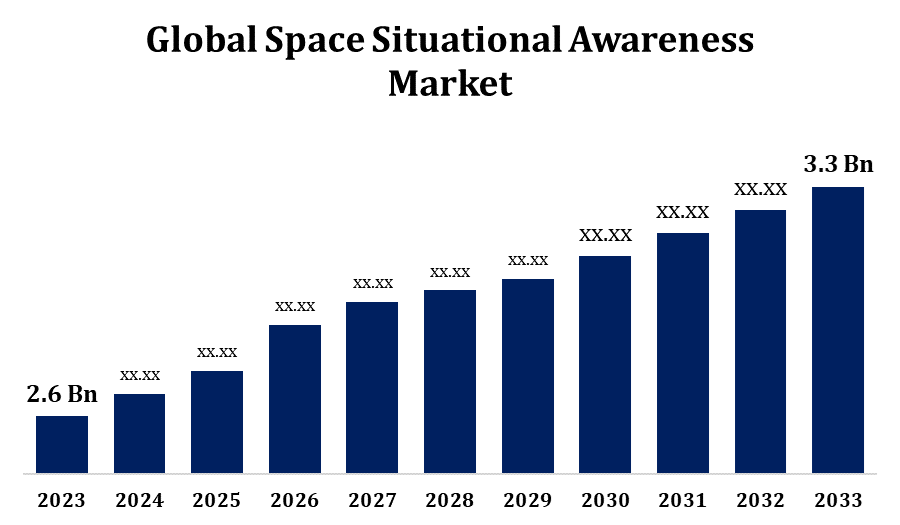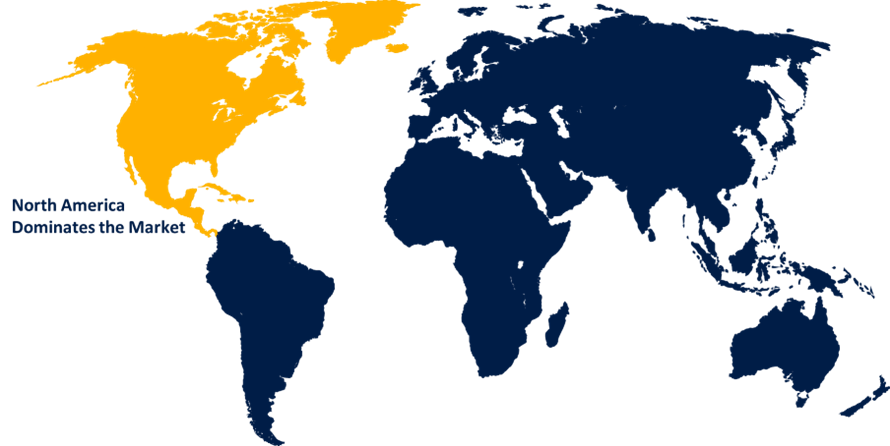Global Space Situational Awareness Market Size To Worth USD 3.3 Billion By 2033 | CAGR of 2.41%
Category: Aerospace & DefenseGlobal Space Situational Awareness Market Size To Worth USD 3.3 Billion By 2033
According to a research report published by Spherical Insights & Consulting, the Global Space Situational Awareness Market Size to Grow from USD 2.6 Billion in 2023 to USD 3.3 Billion by 2033, at a Compound Annual Growth Rate (CAGR) of 2.41% during the forecast period.

Get more details on this report -
Browse key industry insights spread across 230 pages with 110 Market data tables and figures & charts from the report on the "Global Space Situational Awareness Market Size, Share, and COVID-19 Impact Analysis, By Offering (Service [Space Weather Services, Near-Earth Object Detection Services, Space Surveillance and Tracking Services] and Software), By Object (Mission-Related Debris, Rocket Bodies, Fragmentation Debris, Non-Functional Spacecraft, Functional Spacecraft), By End-User (Commercial, Military and Government), and By Region (North America, Europe, Asia-Pacific, Latin America, Middle East, and Africa), Analysis and Forecast 2023 - 2033." Get Detailed Report Description Here:https://www.sphericalinsights.com/reports/space-situational-awareness-market
The Space Situational Awareness market is growing rapidly due to the rising number of satellite deployments, increasing concerns over space debris, and expanding defense and commercial space activities. Space situational awareness involves tracking, monitoring, and predicting the movement of orbital objects to prevent collisions and ensure long-term space sustainability. Key participants include government agencies, defense organizations, commercial satellite operators, and research institutions. Innovations in artificial intelligence, sensor technology, and data analytics are enhancing real-time tracking and decision-making. The demand for space situational awareness solutions is fueled by the growth of mega-constellations, space tourism, and national security requirements. North America dominates the market, led by the United States, followed by Europe and the Asia-Pacific. Ongoing investments in space surveillance and traffic management will continue to drive market expansion.
Space Situational Awareness Market Value Chain Analysis
The Space Situational Awareness market value chain comprises several interconnected stages, beginning with data collection from ground-based and space-based sensors such as radar, telescopes, and satellites. This data is then processed and analyzed using advanced algorithms, artificial intelligence, and cloud computing to track and predict orbital movements. Key contributors at this stage include government space agencies, defense organizations, and private technology firms. The analyzed data is integrated into space traffic management systems, allowing satellite operators and policymakers to make informed decisions. Service providers offer solutions for collision avoidance, debris tracking, and satellite health monitoring. End users include defense agencies, commercial satellite operators, space research institutions, and regulatory bodies. The growing commercialization of space activities is driving investments in advanced tracking and predictive analytics, ensuring greater space safety and sustainability.
Space Situational Awareness Market Opportunity Analysis
The Space Situational Awareness market offers significant growth opportunities driven by the increasing number of satellites, rising space debris, and heightened concerns over space security. As governments and private entities deploy mega-constellations and commercial space missions, the need for advanced tracking and collision avoidance solutions continues to grow. Emerging technologies such as artificial intelligence, machine learning, and big data analytics are enhancing space traffic management and predictive analytics. The expanding role of private companies in space surveillance and the growing need for international cooperation are creating new business opportunities. Additionally, regulatory initiatives and funding for space sustainability programs are fueling market expansion. The rise of commercial applications, including space tourism, asteroid mining, and satellite servicing, is further driving demand for advanced space situational awareness solutions, ensuring long-term industry growth.
The growing frequency of satellite launches and the expansion of global space activities are driving the growth of the Space Situational Awareness market. With the rapid deployment of mega-constellations, commercial satellites, and government missions, the demand for effective tracking, collision avoidance, and debris management has intensified. Increased investments in space exploration, defense surveillance, and communication satellites further boost market demand. Governments and private entities are developing advanced monitoring systems utilizing artificial intelligence, machine learning, and real-time analytics to enhance orbital safety. Additionally, the rise in space tourism and deep-space missions underscores the need for comprehensive space situational awareness solutions. Strengthening regulatory frameworks and international collaborations are playing a crucial role in ensuring long-term sustainability and security in Earth's increasingly crowded orbital environment.
A major challenge in the Space Situational Awareness market is the growing congestion of Earth's orbit due to the increasing number of satellites and space debris, making precise tracking and collision prevention more complex. Limited global coordination and regulatory inconsistencies create obstacles for effective space traffic management. The high costs associated with developing and maintaining advanced monitoring systems, including ground-based and space-based sensors, pose financial difficulties for smaller organizations. Additionally, integrating data from multiple sources while ensuring real-time accuracy remains a technical challenge. Cybersecurity threats targeting satellite communication and tracking systems further heighten risks. As space activities continue to expand, overcoming these challenges through international cooperation, technological innovation, and strong policy frameworks will be essential for ensuring sustainable and secure space operations.
Insights by Offering
The services segment accounted for the largest market share over the forecast period 2023 to 2033. Governments, defense organizations, and commercial satellite operators are increasingly investing in advanced monitoring services to improve space safety and operational efficiency. Key offerings include space traffic management, risk assessment, satellite health monitoring, and predictive analytics, powered by advancements in artificial intelligence and big data. As satellite launches and mega-constellations continue to grow, service providers are introducing subscription-based and customized solutions to cater to diverse industry requirements. Additionally, rising concerns over space security and regulatory compliance are further driving demand for specialized space situational awareness services. With ongoing technological advancements and strategic partnerships, this segment is expected to experience steady expansion, playing a crucial role in ensuring the sustainability and security of space operations.
Insights by Object
The non-functional spacecraft segment accounted for the largest market share over the forecast period 2023 to 2033. The increasing number of satellite launches has led to a growing accumulation of inactive spacecraft, posing significant risks to operational satellites and future missions. To address these challenges, governments and space agencies are investing in tracking and monitoring solutions to enhance orbital safety and prevent collisions. Emerging technologies, including AI-driven analytics, automated tracking systems, and laser-based debris removal, are being explored for effective management of non-functional satellites. Regulatory bodies are also advocating for sustainable space practices, such as end-of-life disposal strategies, to reduce space debris. With a stronger focus on space traffic management and debris mitigation, the demand for advanced tracking and removal solutions for inactive spacecraft is expected to grow substantially in the coming years.
Insights by End User
The commercial segment accounted for the largest market share over the forecast period 2023 to 2033. The growth of the commercial segment is driven by the increasing number of private satellite launches and the expansion of space-based activities. Companies in satellite communications, Earth observation, and space services are investing in advanced tracking and collision avoidance solutions to protect their assets and extend their operational lifespan. The rise of mega-constellations, space tourism, and in-orbit servicing has further increased the demand for real-time monitoring and predictive analytics. Private enterprises are collaborating with government agencies and utilizing AI, machine learning, and big data to improve space traffic management. Additionally, regulatory requirements and the need for space sustainability are prompting commercial firms to adopt proactive space situational awareness strategies, positioning this segment as a key driver of market growth.
Insights by Region

Get more details on this report -
North America is anticipated to dominate the Space Situational Awareness Market from 2023 to 2033. The United States dominates the region, with key contributions from NASA, the U.S. Space Force, and private companies like SpaceX and Lockheed Martin. The increasing number of satellite launches, defense applications, and commercial space ventures has driven demand for advanced tracking, collision avoidance, and debris management solutions. The presence of leading aerospace and defense firms, combined with significant research and development initiatives, further accelerates market growth. Additionally, growing concerns over space congestion and national security have led to policy advancements and increased funding for space situational awareness programs. With continuous innovation and strategic collaborations, North America is expected to retain its leadership position in the global market, shaping the future of space traffic management and orbital safety.
Asia Pacific is witnessing the fastest market growth between 2023 to 2033. Organizations such as ISRO, CNSA, and JAXA are making significant investments in space surveillance, debris tracking, and satellite navigation systems. The expanding role of private companies in satellite launches and space services is further driving market growth in the region. Additionally, regional governments are enhancing space policies and fostering international collaborations to improve orbital safety. With rising investments in artificial intelligence, data analytics, and advanced sensor technologies, the Asia-Pacific region is emerging as a key player in global space situational awareness. As space congestion increases, these advancements will play a crucial role in ensuring sustainable and secure space operations.
Recent Market Developments
- In October 2023, EnduroSat, a prominent provider of space and satellite technology, has announced its plans to develop European space situational awareness systems for commercial missions. The company aims to design and manufacture ESPA microsatellites, with the goal of deploying them in low Earth orbit.
Major players in the market
- Elecnor Deimos Group
- Etamax Space
- Exoanalytic Solutions
- Globvision
- Kratos Defense & Security Solutions, Inc.
- L3harris Technologies
- Lockheed Martin Corporation
- Northstar Earth & Space Inc.
- Parsons Corporation
- Peraton
- Schafer Corporation
- Spacenav
- Telespazio
- Others
Market Segmentation
This study forecasts revenue at global, regional, and country levels from 2023 to 2033.
Space Situational Awareness Market, Offering Analysis
- Service
- Space Weather Services
- Near-Earth Object Detection Services
- Space Surveillance and Tracking Services
- Software
Space Situational Awareness Market, Object Analysis
- Mission-Related Debris
- Rocket Bodies
- Fragmentation Debris
- Non-Functional Spacecraft
- Functional Spacecraft
Space Situational Awareness Market, End User Analysis
- Commercial
- Military
- Government
Space Situational Awareness Market, Regional Analysis
- North America
- US
- Canada
- Mexico
- Europe
- Germany
- Uk
- France
- Italy
- Spain
- Russia
- Rest of Europe
- Asia Pacific
- China
- Japan
- India
- South Korea
- Australia
- Rest of Asia Pacific
- South America
- Brazil
- Argentina
- Rest of South America
- Middle East & Africa
- UAE
- Saudi Arabia
- Qatar
- South Africa
- Rest of the Middle East & Africa
About the Spherical Insights & Consulting
Spherical Insights & Consulting is a market research and consulting firm which provides actionable market research study, quantitative forecasting and trends analysis provides forward-looking insight especially designed for decision makers and aids ROI.
Which is catering to different industry such as financial sectors, industrial sectors, government organizations, universities, non-profits and corporations. The company's mission is to work with businesses to achieve business objectives and maintain strategic improvements.
CONTACT US:
For More Information on Your Target Market, Please Contact Us Below:
Phone: +1 303 800 4326 (the U.S.)
Phone: +91 90289 24100 (APAC)
Email: inquiry@sphericalinsights.com, sales@sphericalinsights.com
Contact Us: https://www.sphericalinsights.com/contact-us
Need help to buy this report?